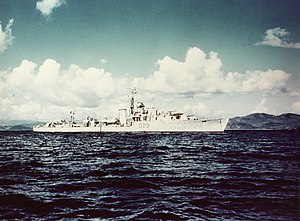HMS Charity (R29)
 HMS Charity engaged in Operation Fishnet off North Korea, 16 September 1952.
| |
| History | |
|---|---|
| Name | HMS Charity |
| Builder | John I. Thornycroft and Company and Company, Woolston, Southampton |
| Laid down | 9 July 1943 |
| Launched | 30 November 1944 |
| Commissioned | 19 November 1945 |
| Out of service | 16 June 1958 |
| Identification | Pennant number: R29, changed to D29 |
| Honours and awards | Korean War |
| Fate | Sold to US Navy for later sale to the Pakistan Navy |
| Name | PNS Shah Jahan |
| Commissioned | 16 December 1958 |
| Homeport | Karachi |
| Identification | Pennant number: DD-962 |
| Honours and awards | Indo-Pakistan War of 1971 |
| Fate | Damaged by SS-N-2 missile and scrapped |
| General characteristics | |
| Class and type | Template:Sclass2- destroyer |
| Displacement | 1,710 tons (standard) 2,520 tons (full) |
| Length | 363 ft (111 m) o/a |
| Beam | 35.75 ft (10.90 m) |
| Draught |
|
| Propulsion |
|
| Speed | 37 knots (69 km/h) |
| Range | 615 tons oil, 1,400 nautical miles (2,600 km) at 32 knots (59 km/h) |
| Complement | 186 |
| Armament |
|
HMS Charity was a Template:Sclass2- destroyer of the Royal Navy laid down by John I. Thornycroft and Company of Woolston, Southampton on 9 July 1943. She was launched on 30 November 1944 and commissioned on 19 November 1945. She was sold to the US Navy in 1958, for transfer to the Pakistan Navy as a part of the Military Aid Program.
Renamed Shah Jahan, the ship was badly damaged in a strike by Indian Navy missile boats during the Indo-Pakistan War of 1971, and scrapped as a result.
History in the Royal Navy
Commissioned too late for service in the Second World War, Charity's pennant number was soon changed to D29. She formed part of the 14th (later 1st) Destroyer Squadron for service in the Mediterranean.[1] She saw service, along with other Royal Navy ships in preventing illegal immigration into Palestine in 1947.[2]
Following the outbreak of hostilities Charity served during the Korean War, where she joined the 8th Destroyer Flotilla. She steamed 126,000 nautical miles (233,000 km; 145,000 mi) during the war, and her actions included destroying a train.[3] The destroyer received a slight modernization, which involved the removal of one of her rear gun turrets ('X' mounting) which was replaced by mountings for two Squid anti-submarine launchers, which replaced her depth charges. She paid off into reserve in 1955.
History in the Pakistan Navy
Charity was sold to the United States Navy on 16 June 1958, for further transfer to the Pakistan Navy. She was renamed USS Shah Jehan.[4] She was modernized by J. Samuel White in Cowes, England under a US contract and transferred to the Pakistan Navy as part of the Military Assistance Program on 16 December 1958 where she served as Shah Jahan (literally, "Emperor of the World", after Shah Jahan).[5]
Indo-Pakistan War of 1971
During the Indo-Pakistan War of 1971, Shah Jahan was escort to the cargo ship MV Venus Challenger carrying ammunition sent by the United States for the war effort from Saigon to Karachi.
On the night of 4 December 1971, the Indian Navy launched a fast naval strike called Operation Trident on the Pakistani Naval Headquarters of Karachi. The Operation Trident task force consisted of 3 Template:Sclass-s from the 25th "Killer" Missile Boat Squadron (Nipat, Nirghat, and Veer), escorted by two anti-submarine Template:Sclass-s, Katchall and Kiltan,[6][7] which approached Karachi.
The Indian missile boats evaded Pakistani reconnaissance aircraft and patrol vessels and converged at 2150 hours about 70 miles (110 km) south of Karachi, and detected the Pakistani naval vessels on patrol. At 2300 hours, Nipat fired 2 SS-N-2 Styx missiles at Shah Jahan and Venus Challenger. The ammunition aboard Venus Challenger exploded when the ship was hit by the missile, and the vessel quickly sunk. Shah Jahan was also struck by the missile and was irreparably damaged. She was towed back to Karachi and scrapped.
The Pakistani destroyer Khaibar and minesweeper Muhafiz were also sunk in the operation. The missile boats then hit the fuel storage tanks at Karachi harbour, setting them ablaze.[7]
References
- ^ Marriott, Leo (1989). Royal Navy Destroyers Since 1945. Ian Allan Ltd. p. 63.
- ^ Stewart, Ninian (2002). The Royal Navy and the Palestine Patrol. Routledge.
- ^ Keith, James (June 1954). "H.M.S. Charity". Portsmouth Navy News. No. 1. p. 19.
- ^ Gardiner, Robert; Friedman, Norman (eds.). Conway's All The World's Fighting Ships 1947-1982. Naval Institute Press. ISBN 0-87021-923-5.
- ^ Blackman, Raymond V B (ed.). Jane's Fighting Ships 1963-4. London: Sampson Low, Marston & Co. Ltd. p. 194.
- ^ [1] Archived 26 September 2009 at the Wayback Machine
- ^ a b Pike, John. "Indo-Pakistan War of Independence". Globalsecurity.org. Retrieved 22 May 2015.
Publications
- Colledge, J. J.; Warlow, Ben (2006) [1969]. Ships of the Royal Navy: The Complete Record of all Fighting Ships of the Royal Navy (Rev. ed.). London: Chatham Publishing. ISBN 978-1-86176-281-8.
- Marriott, Leo (1989). Royal Navy Destroyers Since 1945. Ian Allan Ltd. ISBN 0-7110-1817-0.
- C-class destroyers (1943) of the Royal Navy
- Ships built in Southampton
- 1944 ships
- World War II destroyers of the United Kingdom
- Cold War destroyers of the United Kingdom
- Korean War destroyers of the United Kingdom
- C-class destroyers (1943) of the Pakistan Navy
- Maritime incidents in 1971
- Ships built by John I. Thornycroft & Company
